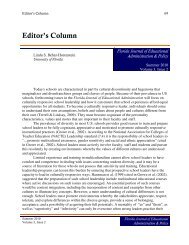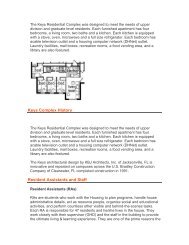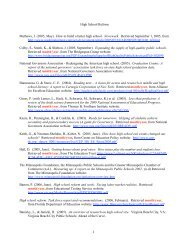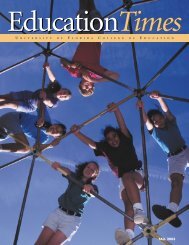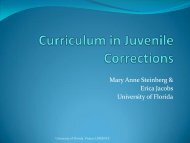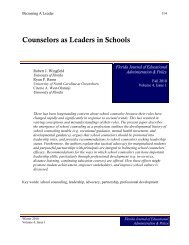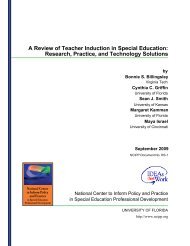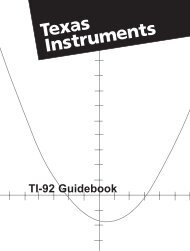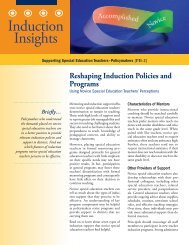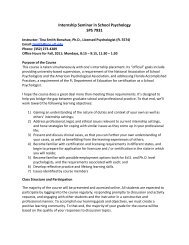Social Skills Interview
Social Skills Interview
Social Skills Interview
You also want an ePaper? Increase the reach of your titles
YUMPU automatically turns print PDFs into web optimized ePapers that Google loves.
PROJECT GATORSS<br />
<strong>Social</strong> <strong>Skills</strong> <strong>Interview</strong><br />
Child’s name __________________________ Age ____________ Sex: M F<br />
Date of <strong>Interview</strong> _______________________<br />
<strong>Interview</strong>er ________________________<br />
Respondent/ Relationship to child ________________________________________________<br />
Placement Type ______________________________________________________________<br />
A. Communication strategies<br />
1. Describe specific communication strategies (appropriate and inappropriate) used by the<br />
child (e.g., vocal speech, signs/gestures, communication boards/books, or disruptive<br />
behaviors).<br />
2. How consistently does the child use these communication strategies during social<br />
interaction opportunities with peers?<br />
3. How does the child respond to complex (2-3 step directions) vs. simple (one step)<br />
directions?<br />
B. Current social behavior<br />
1. For each social behavior, define the topography (i.e., what it looks like) and the frequency<br />
(i.e., how often the child engages in the behavior). Include both appropriate and inappropriate<br />
social behaviors (e.g., positive initiations to peers/adults, negative initiations or responses to<br />
peers/adults, such as yelling, taking toys without asking), and behaviors that are likely to lead to<br />
Revised 7/8/03
p. 2<br />
social interactions such as observing peers’ play, responses to others social initiations. Also<br />
indicate the times/activities in which the child is most likely to display these behaviors.<br />
a. Appropriate social behaviors (e.g., may include gestures, verbal initiations, sharing play<br />
materials, may include passive acceptance, verbal gestures, walking away from peer)<br />
Behavior<br />
Time/Activity<br />
1. _________________________________ ______________________________<br />
2. _________________________________ ______________________________<br />
3. _________________________________ ______________________________<br />
b. Inappropriate social behaviors (e.g., external may include aggression, taking toys,<br />
crying, tantrums, stereotypy; internal may include failure to approach peers who are<br />
socially interacting or no response to peer initiations).<br />
External behaviors<br />
Internal (withdrawn) behaviors<br />
1. _________________________________ ______________________________<br />
2. _________________________________ ______________________________<br />
3. _________________________________ ______________________________<br />
c. Does the child often engage in the same type of play over and over (e.g., with peers, with<br />
materials)? If so, identify the activities that promote different types of play behaviors (i.e.,<br />
cooperative or associative)<br />
d. What medical or physical conditions (if any) does the child have that may affect his or her<br />
social behaviors (e.g., physical impairments, current medications)?
p. 3<br />
e. Does the child’s social behaviors/interaction skills remain constant or change depending<br />
on the activities? If it changes based on activity, identify which activities increase or<br />
decrease likelihood of social behaviors.<br />
Increase:<br />
Decrease:<br />
C. Schedule of <strong>Social</strong> Interaction Opportunities<br />
1. Identify social times and activities (or situational factors) listed below (see project staff<br />
for definition of activities/situational factors) when the child has access to socially<br />
competent peers.<br />
Times/Activities<br />
Dance/Music<br />
Computer<br />
Art<br />
Cognitive <strong>Skills</strong> (matching, color identif.)<br />
Sensory/water play<br />
Pretend/Sociodramatic play<br />
Outdoor play<br />
Manipulatives/blocks<br />
Book Center
p. 4<br />
Situational Factors<br />
1:1 with peer<br />
Small group of peers (2-3 total)<br />
Large group of peers (4 or more total)<br />
Child directed activity<br />
Adult directed activity<br />
Adult engaged in activity<br />
Adult not engaged in activity<br />
2. Are there specific materials that increase appropriate social interactions or increase the<br />
likelihood of problem behaviors/decreased social interactions? If so, please list them<br />
below and describe how they influence social behaviors.<br />
Most Likely:<br />
Least Likely:<br />
3. Does the child have the opportunity to make choices about engaging in social interactions<br />
(i.e., with whom, what activities, etc.)? If so, when and how often and what activities are<br />
typically selected? Does the child typically choose to engage with peers or adults?
p. 5<br />
4. Are there other peer characteristics that make a difference in the child’s display of<br />
appropriate/inappropriate social behaviors (e.g., playing with same gender peers, familiar<br />
peers, older peers, younger peers, more verbal peers)?<br />
D. Antecedent events that predict when the child is most likely and least likely to engage in<br />
appropriate and inappropriate social behavior.<br />
1. With whom is the child most and least likely to interact (include adults and peers and<br />
identify by name)?<br />
Most Likely:<br />
Least Likely:<br />
2. Rate on a scale of 1 (not at all likely) to 5 (highly likely to occur) the likelihood of the<br />
child engaging in an appropriate social interaction due to one of the following:<br />
Not at all likely Highly likely<br />
a. If a peer initiates the interaction? 1 2 3 4 5<br />
b. If a peer responds to his/her initiation? 1 2 3 4 5<br />
c. If an adult actively helps the child get engaged in play with a 1 2 3 4 5<br />
peer(s)?<br />
d. If the adult simply tells the child or peers to play with one 1 2 3 4 5<br />
another?<br />
e. If adult plans activity and child follows through and does 1 2 3 4 5<br />
activity?<br />
f. Target child is in a large group (more than 6 children) of 1 2 3 4 5<br />
peers playing?<br />
g. Target child is in a small group (less than 6 children) of 1 2 3 4 5<br />
peers playing?<br />
h. If the adult directs the activity? 1 2 3 4 5<br />
i. If the child directs the activity? 1 2 3 4 5<br />
j. If the adult is present and participating in the play activity? 1 2 3 4 5
p. 6<br />
k. If the adult is absent and disengaged from the play activity? 1 2 3 4 5<br />
l. If the peers playing are the same gender as the target child? 1 2 3 4 5<br />
3. Rate on a scale of 1 (not at all likely) to 5 (highly likely to occur) the likelihood of the<br />
child engaging in an inappropriate social interaction due to one of the following:<br />
Not at all likely<br />
Highly likely<br />
a. If a peer initiates the interaction? 1 2 3 4 5<br />
b. If a peer responds to his/her initiation? 1 2 3 4 5<br />
c. If an adult actively helps the child get engaged in play with a<br />
peer(s)?<br />
d. If the adult simply tells the child or peers to play with one<br />
another?<br />
e. If adult plans activity and child follows through and does<br />
activity?<br />
1 2 3 4 5<br />
1 2 3 4 5<br />
1 2 3 4 5<br />
f. Target child is in a large group (more than 6 children) of 1 2 3 4 5<br />
peers playing?<br />
g. Target child is in a small group (less than 6 children) of 1 2 3 4 5<br />
peers playing?<br />
h. If the adult directs the activity? 1 2 3 4 5<br />
i. If the child directs the activity? 1 2 3 4 5<br />
j. If the adult is present and participating in the play activity? 1 2 3 4 5<br />
k. If the adult is absent and disengaged from the play activity? 1 2 3 4 5<br />
l. If the peers playing are the same gender as the target child? 1 2 3 4 5<br />
4. Are there particular idiosyncratic situations or events not listed above that may increase<br />
or decrease the occurrence of appropriate and inappropriate social interactions (e.g.,<br />
presence or absence of certain peers, types of directions, transitions, presence or absence<br />
of certain toys)?<br />
Increase:<br />
Decrease:
p. 7<br />
5. What one thing could you or do you do or could happen that would most likely encourage<br />
Encourage:<br />
or discourage the child to positively interact with peers?<br />
Discourage:<br />
E. Identification of consequences or perceived outcomes of appropriate and inappropriate social<br />
behaviors (i.e., the functions the behaviors serve for that child in particular situations).<br />
1. What do you think the child obtains from social interactions, whether appropriate or<br />
inappropriate (i.e., peer/adult attention, self reinforcement, play materials, etc.)?<br />
2. What do think the child escapes if s/he chooses to not engage in social interactions (i.e.,<br />
peer/adult attention, activity, situation, etc.)?<br />
3. Do appropriate or inappropriate social initiations result in successful outcomes for the<br />
child (i.e., does s/he obtain attention or tangibles)?<br />
F. Description of interventions to use or avoid in working with and supporting this child during<br />
social situations.<br />
1. What strategies used in the past have been successful at improving the child’s social<br />
interactions?
p. 8<br />
2. What things should be avoided that might interfere with or disrupt a social situation with<br />
this child (such as particular adult demands, crowded situation, noisy toys, lights etc.)?<br />
3. What strategies are you currently using to promote appropriate social behaviors?<br />
4. What strategies are you currently using to decrease inappropriate social behaviors?<br />
5. How much does adult proximity predict the child’s engagement in social interactions?<br />
Adult in proximity:<br />
Adult not in proximity:<br />
G. Questions Related to Restricted Interests<br />
1. Often times, children with autism have particular objects, items, or topics that they are<br />
preoccupied with. We are trying to gather information to see if the child has any interests<br />
like this. Does the child frequently and repeatedly engage with a specific object or item<br />
(e.g., Disney characters, a certain color), and/or want to discuss a particular topic for long<br />
periods of time? If so, please list the object or items and describe the child’s behavior<br />
with that object, item, or topic.<br />
______________________________________________________________________________<br />
______________________________________________________________________________<br />
______________________________________________________________________________<br />
______________________________________________________________________________<br />
______________________________________________________________________________
p. 9<br />
2. Will s/he allow peers to play with that object or item, or talk with peers about the topic of<br />
interest?<br />
______________________________________________________________________________<br />
______________________________________________________________________________<br />
3. Does the child become upset or frustrated if others want to play with the same object or<br />
join in the conversation about the topic?<br />
______________________________________________________________________________<br />
______________________________________________________________________________



